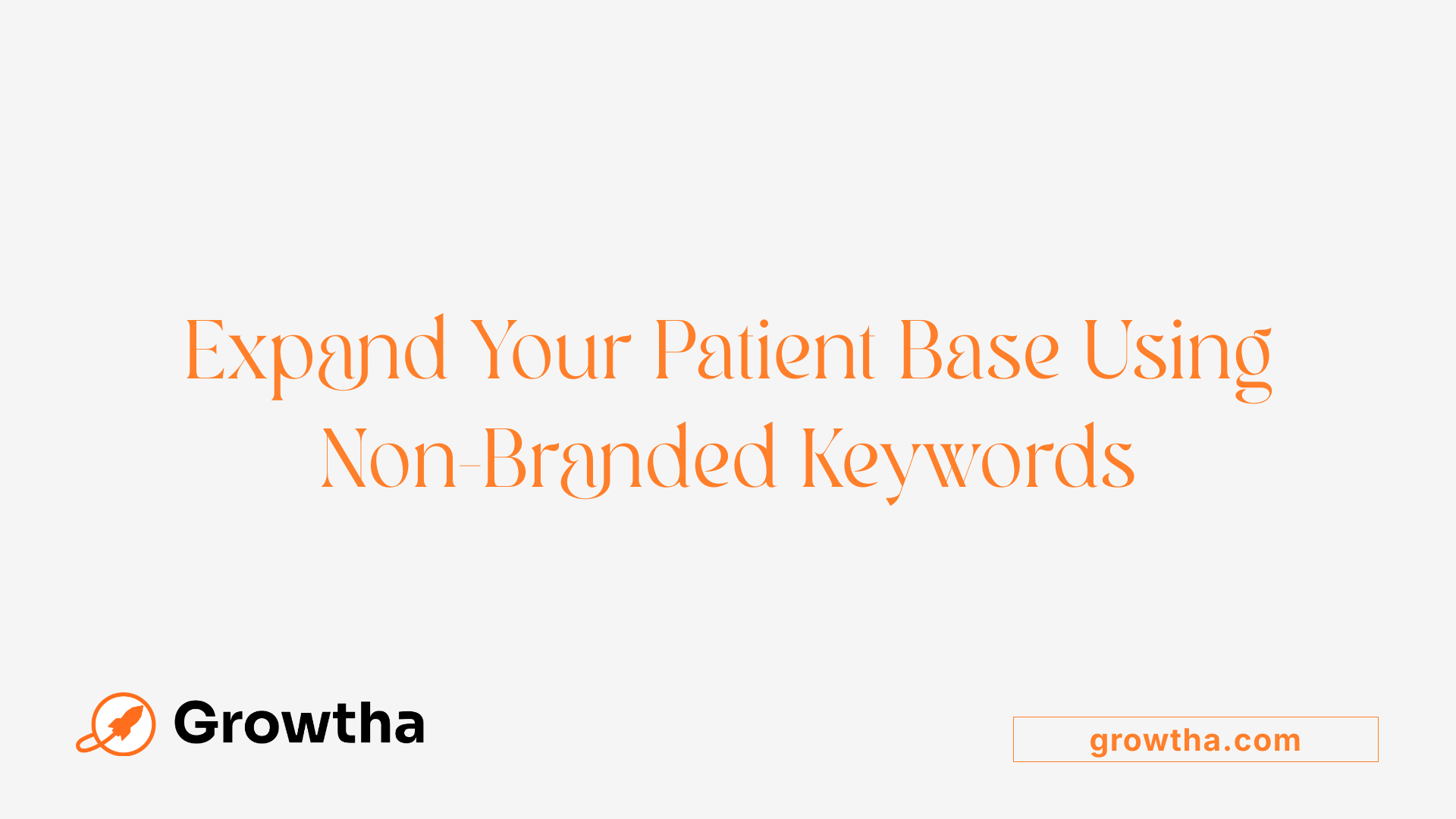Branded vs Non-Branded Keywords in Healthcare SEO
Enhancing Healthcare Visibility through Strategic Keyword Use


Branded vs Non-Branded Keywords in Healthcare SEO
Understanding the Core Concepts of Healthcare SEO Keywords
In the evolving landscape of healthcare digital marketing, understanding the distinction between branded and non-branded keywords is fundamental. Healthcare providers leverage these keyword types to attract different patient segments, optimize search rankings, and build a robust online presence. This article explores the nuances of each, their strategic benefits, and how to effectively harness their potential for comprehensive healthcare SEO success.
Defining Branded and Non-Branded Keywords in Healthcare SEO
What are branded keywords with examples?
Branded keywords in healthcare SEO are search terms that include the name of a specific healthcare provider, product, or related brand. For instance, 'Mayo Clinic,' 'Cleveland Clinic cardiology,' or 'Dr. John Smith Botox' are examples of branded keywords. They directly connect users to a particular healthcare institution or professional, often reflecting high user intent to find or visit that brand.
These keywords are essential for maintaining and enhancing a healthcare organization's online reputation. They also attract patients who are already familiar with the brand or seeking specific services offered by that brand.
What are non-branded keywords with examples?
Non-branded keywords are broader and do not include specific brand names. Examples include 'skin specialist near me,' 'pediatric care for infants,' or 'treatment options for depression.' These terms target a wide audience searching for healthcare services without referencing a particular provider.
Non-branded keywords are vital for increasing organic visibility and attracting new patients who are in the early stages of their healthcare research process. They help healthcare providers reach potential patients who may not yet be aware of their brand.
How does keyword variation influence healthcare marketing?
Using variations and misspellings of both branded and non-branded keywords ensures comprehensive coverage. For example, 'Mayo clinic' and 'MayoClinic' are variations that help capture more traffic. Incorporating different forms of these keywords can help healthcare practices appear across diverse search queries.
Strategically combining branded keywords—focused on brand recognition—and non-branded keywords—targeting broader informational searches—creates a powerful SEO approach. This balanced mix helps clinics and hospitals maximize visibility at different stages of patient decision-making, from general inquiry to specific service searches.
| Keyword Type | Examples | Purpose | Traffic Level | Competition |
|---|---|---|---|---|
| Branded Keywords | 'WebMD' for WebMD, 'Cleveland Clinic' | Drive brand awareness, establish authority | Usually lower CPC | Usually lower competition |
| Non-Branded Keywords | 'heart surgery,' 'pediatric vaccine' | Attract new visitors, increase general visibility | Higher search volume | Higher competition |
Understanding and utilizing the differences between branded and non-branded keywords allow healthcare providers to create a more effective online presence. Targeted use of both types ensures that marketing efforts reach the right audience at the right time, supporting overall growth and patient engagement.
The Strategic Significance of Branded Keywords in Healthcare

What are the benefits of using branded keywords in healthcare SEO?
In healthcare marketing, incorporating branded keywords into SEO strategies offers multiple advantages. First, they significantly boost a healthcare provider’s online visibility by ensuring that the practice appears prominently when patients search for the practice directly. This helps reinforce the healthcare brand’s authority and solidify its reputation within the community.
Branded keywords often lead to higher conversion rates because users searching with specific brand terms have a clear intent—they already know about the practice or are actively seeking its services. This high intent makes branded keywords particularly cost-effective, as they typically face less competition and have lower cost-per-click (CPC) rates.
Additionally, focusing on branded keywords protects a healthcare organization’s online reputation. If competitors attempt to bid on the brand name, the practice can safeguard its search presence and ensure patients find accurate, official information. Moreover, branded keywords support promotional campaigns, such as new service launches or special events, by driving targeted traffic to dedicated landing pages.
Overall, using branded keywords strategically in healthcare SEO helps attract high-quality patients, improve search rankings, reinforce brand loyalty, and maximize marketing ROI—all crucial for growth and sustainability in a competitive healthcare landscape.
Maximizing Reach with Non-Branded Keywords in Healthcare

What are the benefits of using non-branded keywords in healthcare SEO?
In the healthcare sector, incorporating non-branded keywords into your SEO strategy can yield significant benefits. These keywords—generic terms that relate to healthcare services without mentioning specific provider names—play a crucial role in broadening your online visibility.
One of the main advantages is their higher search volumes. Non-branded keywords attract a larger pool of potential patients, especially those conducting early-stage research about symptoms, conditions, or treatments. Because they are more general, they tend to face less competition compared to branded keywords, making ranking easier and more cost-effective.
Supporting educational and awareness campaigns is another key benefit. Non-branded terms help disseminate valuable health information, guiding users to your website for authoritative content. This not only boosts your search rankings but also establishes your practice as a trusted authority in your specialty.
Furthermore, focusing on non-branded keywords increases organic traffic, which is vital for long-term growth. It reduces reliance on branded searches, making your practice resilient to shifts in brand awareness or reputation fluctuations. Over time, this approach helps build a strong online presence that's both diverse and sustainable.
By integrating non-branded keywords into your healthcare SEO, you connect with a wider audience at different stages of their health journey. This strategy supports more effective content marketing, improves search engine rankings, and enhances your authority in the healthcare industry, ultimately attracting new patients and fostering growth.
The Impact of Keyword Types on Search Rankings and Visibility
How do branded and non-branded keywords influence search rankings and visibility in healthcare SEO?
Branded and non-branded keywords each play a vital role in healthcare SEO by addressing different search intents and audience segments. Branded keywords include the name of healthcare practices, specific doctors, or treatments, such as 'Mayo Clinic' or 'Dr. Jane Smith.' These keywords typically attract users who are already familiar with the healthcare provider and are closer to making a decision. As a result, they often lead to higher rankings for brand-related searches and possess higher conversion potential.
On the other hand, non-branded keywords are broader and do not include the company's name. They cover general topics like 'heart surgery' or 'pediatric care,' targeting users at the top of the funnel who are still researching their options. These keywords tend to have higher search volumes and lower competition, which makes them highly effective for increasing organic traffic and establishing authority.
In combining both keyword types within website content, meta descriptions, and local SEO efforts, healthcare providers can boost relevance and build authority. Branded keywords reinforce online reputation and help control conversations around the brand, while non-branded keywords attract new visitors and expand overall visibility. This dual approach ensures comprehensive coverage of patient search intent, from initial research to booking appointments.
Optimizing for both enhances rankings, improves relevance, and supports long-term growth. A balanced mix minimizes visibility gaps, sustains brand authority, and captures a wide spectrum of search traffic. Regular analysis of keyword performance can guide resource allocation to the most effective efforts, ultimately strengthening the healthcare provider's online presence.
Developing an Effective Keyword Strategy in Healthcare SEO
Conducting comprehensive keyword research
Effective healthcare SEO begins with thorough keyword research. It involves identifying both branded and non-branded keywords that potential patients use when searching for services. Branded keywords include specific practice names, doctors, or branded procedures, which attract users already familiar with the healthcare provider. Non-branded keywords focus on generic terms like 'heart specialist' or 'pediatric care,' helping to reach a broader audience.
Utilize tools such as Google Search Console, keyword research platforms, and social media mentions to gather relevant terms. Understanding search volume, competition, and user intent for each keyword type enables strategic planning.
Creating dedicated content for each keyword type
Tailoring content according to keyword categories enhances relevance and rankings. For branded keywords, develop dedicated service pages, doctor profiles, and reputation management content that reinforce the brand’s authority.
For non-branded keywords, focus on educational blog posts, FAQs, and informational resources that address common health concerns. This not only attracts new visitors but also positions the healthcare provider as an authority in the field.
This strategy ensures that content aligns with what users are searching for, improving both visibility and user engagement.
Segregating campaigns for performance tracking
To accurately measure success, separate campaigns for branded and non-branded keywords are essential. This structure allows for detailed analysis of each category’s performance, including click-through rates, conversions, and overall traffic.
Implement local SEO tactics within each campaign, such as location-based keywords and schema markup, to target specific communities. Use tools like seoClarity or Google Ads’ campaign segmentation to monitor and adjust strategies continuously.
Segmenting campaigns ensures that marketing efforts are optimized efficiently, allocating budget and resources to the most effective keywords.
How can healthcare providers optimize their keyword strategies?
To effectively balance and optimize branded versus non-branded keywords in healthcare SEO campaigns, it is essential to conduct comprehensive keyword research to identify high-potential terms for each category. Developing dedicated content tailored to these keywords—such as branded service pages and educational blog posts—enhances relevance. Separate campaign structures allow for precise performance tracking and optimization. Incorporating local SEO tactics, on-page optimization, schema markup, and continuous monitoring ensures that both keyword types contribute positively to overall visibility and ROI. This strategic segmentation ensures targeted outreach to both existing patients and new audiences.
Integrating Keywords into Healthcare Digital Marketing Efforts

What role do branded and non-branded keywords play within healthcare digital marketing efforts?
Branded and non-branded keywords are fundamental components of a successful healthcare digital marketing strategy. They serve different purposes and target audiences at various stages of the patient journey.
Branded keywords include the name of the healthcare provider, specific doctors, or treatments associated with the organization. These keywords typically attract individuals who are already aware of the provider and are closer to making a decision. As a result, branded keywords tend to generate higher conversion rates and help reinforce the provider’s reputation online.
On the other hand, non-branded keywords are generic terms related to health services or conditions, like 'pediatric care' or 'heart surgery.' These keywords are essential for reaching prospective patients during the awareness and research phases. They help expand visibility to audiences unfamiliar with the provider, thus increasing organic traffic and building awareness.
Incorporating both types of keywords allows healthcare organizations to cover all stages of the patient journey—from initial awareness to final decision. An effective strategy often involves personalized campaigns that target each segment distinctly. Paid search tactics like PPC (Pay-Per-Click) and remarketing are used to reinforce messages and encourage conversions.
Ultimately, blending branded and non-branded keywords helps healthcare providers build trust, improve search rankings, and expand their reach. This comprehensive approach supports reputation management, patient acquisition, and long-term growth, ensuring that both new and existing patients find the relevant information they need at every step of their healthcare experience.
Leveraging Keywords for Healthcare Website Optimization

How can healthcare providers effectively leverage branded and non-branded keywords to improve website SEO?
Healthcare providers benefit immensely from a balanced approach to keyword usage. Branded keywords, which include the practice or doctor’s name, help target users who are already familiar with the healthcare provider and are closer to making a decision. For example, optimizing for terms like 'Mayo Clinic' or 'Dr. John Doe' captures high-intent traffic and strengthens brand authority.
Non-branded keywords, such as 'heart surgery' or 'pediatric care,' attract new visitors unfamiliar with the practice. These broader, informational keywords have higher search volumes and lower competition, making them essential for top-of-funnel awareness.
Effective strategies involve in-depth keyword research to find relevant long-tail and variations that match patient search intent. These keywords should be integrated thoughtfully into on-page elements—meta titles, descriptions, headers, and URL structures—to increase relevance and search engine rankings.
Local SEO plays a crucial role in healthcare marketing. Optimizing Google Business Profiles, maintaining consistent NAP (Name, Address, Phone number) citations across directories, and targeting location-specific keywords help attract nearby patients.
To sustain and improve SEO efforts, regular monitoring of metrics like search rankings, website traffic, and patient conversions is critical. This data guides necessary technical adjustments, such as improving site speed, optimizing for mobile responsiveness, and implementing schema markup, which enhances visibility in local searches.
By combining these practices, healthcare providers can build a comprehensive SEO strategy that attracts new patients, reinforces existing relationships, and maintains a strong online presence.
Measuring Success and Continuous Improvement in Healthcare SEO

How do I track key metrics like CTR, conversions, and traffic?
Monitoring important SEO performance indicators is vital for healthcare organizations aiming to improve their online presence. Click-through rate (CTR) shows how many users click on your website from search engine results, reflecting the effectiveness of your titles and meta descriptions. Conversion rates reveal how many visitors complete desired actions, such as booking an appointment or requesting information. Traffic metrics give insight into the number of visitors driven to your site through organic search.
Regularly reviewing these metrics helps identify which keywords and content strategies work best. Healthcare practices often focus on branded keywords, which tend to have higher conversion rates, and non-branded keywords, which attract broader audiences.
How can I use analytics tools for performance measurement?
Tools like Google Analytics and Google Search Console are essential for tracking SEO success in healthcare. Google Analytics provides detailed data on visitor behavior, source of traffic, and conversion paths. Google Search Console helps monitor keyword rankings, indexing status, and search impressions.
Using these tools, healthcare providers can analyze how well they rank for both branded and non-branded keywords. Segmenting this data uncovers areas for improvement and growth opportunities.
How do I adjust strategies based on data insights?
Data-driven adjustments are key to ongoing SEO success. If analytics show low traffic or CTR for non-branded keywords, consider optimizing content around industry-specific terms and informational keywords to reach new audiences.
Conversely, if branded keyword rankings decline, reinforcing brand reputation through review management and branded content becomes important. Regularly updating keyword strategies, refining content, and optimizing technical SEO based on analytics insights ensures continuous growth and improved ROI.
Optimizing healthcare SEO is an ongoing process. Consistent measurement and strategic adaptation based on performance data help attract new patients, increase visibility, and strengthen online reputation.
Conclusion: Building a Cohesive Healthcare SEO Strategy
The importance of balancing both keyword types
A successful healthcare SEO plan hinges on the strategic combination of branded and non-branded keywords. While branded keywords, like the specific names of healthcare providers or treatments such as "Mayo Clinic" or "XBrand knee replacement," directly connect users to a known entity, non-branded keywords like "pediatric care" or "heart surgery" attract broader audiences who are early in their research journey. Balancing both ensures that the practice appears both in immediate, high-intent searches and in wider informational contexts.
Long-term ROI from integrated keyword approach
Utilizing a mix of branded and non-branded keywords not only enhances visibility but also improves return on investment over time. Branded keywords typically lead to higher conversion rates since searchers are more familiar with the institution, whereas non-branded keywords generate larger organic traffic volumes and awareness. Separating campaigns enables targeted measurement of each approach’s effectiveness, supporting continuous optimization. Over time, this integrated method fosters loyalty, attracts new patients, and solidifies online reputation.
Future trends in healthcare SEO
Emerging trends indicate increasing importance of local SEO and AI-driven search personalization, which will demand more nuanced keyword strategies. As search engines become more sophisticated, healthcare providers will need to refine their focus on voice search, natural language queries, and personalized content that aligns with both branded and non-branded search intent. Staying adaptable and regularly updating keyword tactics will ensure healthcare organizations remain visible and competitive in an evolving digital landscape.
| Aspect | Branded Keywords | Non-branded Keywords | Strategic Focus |
|---|---|---|---|
| Purpose | Directs to known entity | Builds awareness | Customer acquisition |
| Search Intent | Transactional, high intent | Informational, broad | Funnel coverage |
| Competition | Lower CPC, easier ranking | Higher competition | Consistency in optimization |
| Long-Term Benefit | Reinforces brand authority | Expands market reach | Sustained growth |
Implementing a well-balanced healthcare SEO strategy that leverages both keyword types ensures comprehensive coverage, improved brand visibility, and long-term success in attracting and retaining patients.
Towards a Holistic Approach to Healthcare SEO
A well-rounded healthcare SEO strategy incorporates both branded and non-branded keywords to maximize online visibility, attract diverse patient groups, and foster long-term growth. By conducting targeted keyword research, creating tailored content, and continuously monitoring performance, healthcare providers can develop a resilient digital presence that adapts to evolving search behaviors. Embracing this balanced approach not only enhances search rankings but also ensures that a healthcare organization remains competitive and trustworthy in the digital age, ultimately leading to better patient engagement and outcomes.
References
- Branded vs. Non-Branded Keywords: Which Should You Target?
- Branded vs. Non-Branded Keywords: What They Are + How to Use ...
- Keyword Basics: Branded vs. Non-branded and (Not Provided)
- Branded vs Non-Branded Traffic: What's More Important for SEO?
- Creating a Balance between Branded and Non-Branded Keywords
- Branded Vs. Non-Branded Keywords in Healthcare - WinSavvy
- Branded vs. Non-Branded Keywords for Higher Ed Sites - EAB







